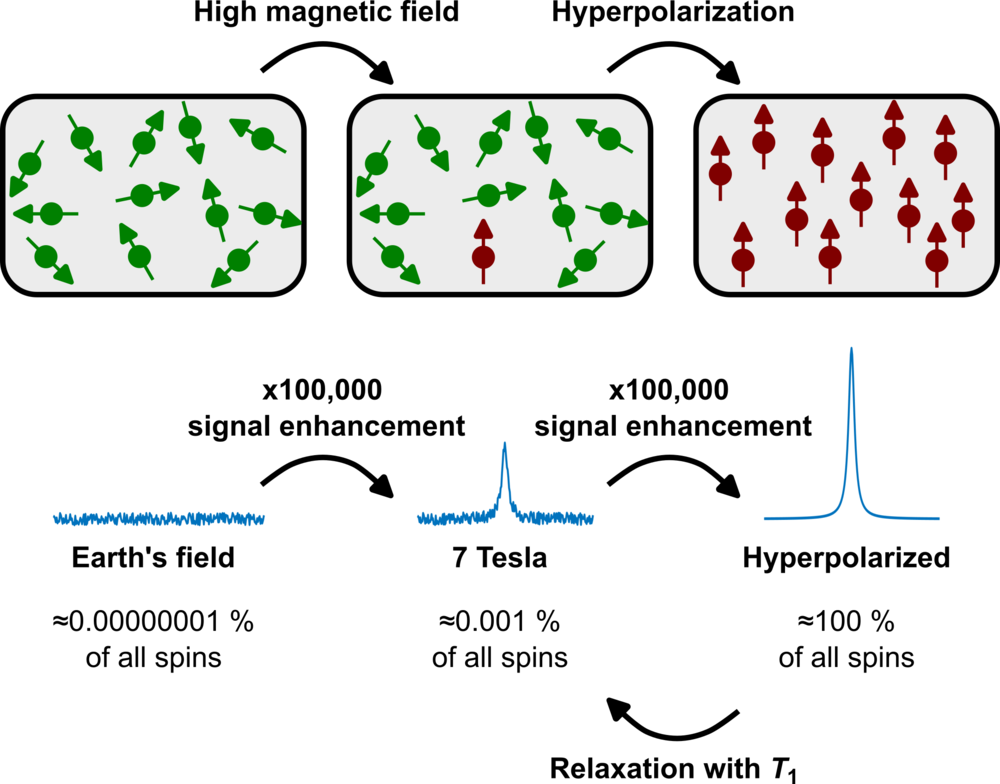Hyperpolarization
Background and Freiburg Research ActivitiesHyperpolarization has revolutionized molecular magnetic resonance imaging (MRI) by enabling the non-invasive detection of metabolites in vivo. Traditional MRI relies on the polarization of 1H in water and lipids, the most abundant substances in vivo, but its low sensitivity limits the visualization of lower concentrated molecules, e.g. dynamic metabolic processes. Parahydrogen-based hyperpolarization methods, including parahydrogen-induced polarization (PHIP) and signal amplification by reversible exchange (SABRE), offer a promising solution to this problem. PHIP generates hyperpolarization in the liquid state through the addition of parahydrogen to unsaturated molecules. SABRE uses the reversible exchange of parahydrogen and the substrate to transfer the polarization to the desired substrate's nucleus. We and others have demonstrated that both methods can produce highly polarized contrast agents in a fast, high-throughput, and cost-effective manner with great potential for in vivo imaging applications.
However, to use parahydrogen for producing hyperpolarized contrast agents for biomedical applications, several challenges must be overcome. The process of obtaining a hyperpolarized contrast agent from parahydrogen involves several steps, including bringing parahydrogen and the target molecule efficiently into contact, transferring the parahydrogen spin order to the target molecule, and rapid purifying and assuring the quality of the contrast agent solution prior to in vivo administration.
Our team is working on all these disciplines of parahydrogen research with a particular focus on translating these promising techniques to preclinical studies and developing new agents for metabolic imaging. We are also investigating ways to improve the efficiency and sensitivity of these methods to increase the amount of information that can be obtained from molecular imaging with the ultimate goal of improving diagnostic capabilities and patient outcomes.
In summary, parahydrogen-based hyperpolarization techniques offer a promising solution for improving the sensitivity and specificity of molecular imaging. Our work on optimizing these methods and developing new hyperpolarized agents has the potential to significantly advance the field of molecular imaging and ultimately benefit patients.

Schematic showing the alignment of nuclear spins. MRI typically uses high field superconducting magnets to enhance the MRI signal by aligning the spins (i.e. polarizing). Still, even at Tesla fields, the technique is mostly limited to imaging the most abundant nuclei and substances in vivo (i.e. hydrogen atoms in water and lipids). By nuclear hyperpolarization, the spins are temporarily massively aligned, which can be employed to detect low concentrated molecules involved in metabolic processes for molecular imaging.
Dr. Andreas B. Schmidt
Head of Hyperpolarization
Tel.: +49 761 270-93880
E-Mail: andreas.schmidt@uniklinik-freiburg.de
University Medical Center Freiburg
Dept. of Radiology · Medical Physics
Killianstr. 5a
79106 Freiburg


